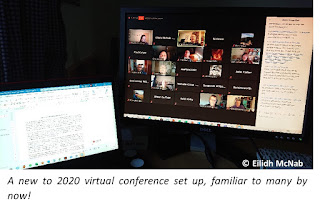by Rachel Hudson
 |
| Myths and motifs (c) Rachel Hudson |
Who knew that the
old myth of bats getting caught in women’s hair was a way to deter young girls
from going out at night? Or that Darth Vader’s mask and his TIE Fighter spaceships
were inspired by a bat?
I unearthed these little nuggets and made many other surprising discoveries on
my journey to illustrate The Map of the
Bat, a patchwork story quilt.
For my day job I
am a freelance illustrator working with leaders in nature conservation and
publishers to champion species and highlight the issues they face. I have
worked with BBC Wildlife Magazine, Bloomsbury Wildlife and my first children’s
book, 100 Endangered Species, was
published this May by Button Books. (You might have seen the logo I created for
the BCT’s podcast, Bat Chat.)
A Map of Many Threads
My bat quilt is
part of my ongoing mission to rehabilitate the reputation of mispresented and
misunderstood animals in a fun and engaging way. I chose to make a quilt
because it is a way of exploring the different stories of the bat in an
accessible way to reach a broad audience, nature lovers as well as those less
aware of the conservation issues. Story quilting also has a rich history of
social commentary, an art form that features in many different cultures around
the world. As Chris Packham,
President of BCT, has urged, “Bats need
to be part of our culture. We need to see them in everyday life… It’s about a
manifestation we can connect with.” (Packham, 2020).
 |
| Map of the Bat story quilt (c) Rachel Hudson |
The quilt is a
semi-abstract map of a bat’s journey 'to redemption', from creepy creature of
the night to ecological superhero. It charts the bat’s night flight across the
landscape, indicated by straight black lines representing hedges, roads,
rivers. It is a journey through time and different histories. My map also makes
visible the mental mapping of the bat, or ‘batnav’, looping in and out of these
cultural geographies (represented by the coloured meandering line). The
quilting pattern through the entire map makes visible echolocation used by some
species.
I chose fabric patterns for their symbolic
significance: the night sky, insect prey, habitats and development - all scraps
gathered from family, friends and creatives, some of whom lost their jobs
making curtains and costumes during the pandemic. I used graduated colour for
the patchwork to unify the illustration. Greys and indigo blues signify
ambiguity, ignorance and the beauty of the night. Oranges and reds
paradoxically signify threats and illumination.
Creature of the Night or Potent Totem?
From medieval manuscripts
and gargoyles, to Gothic novels, DC comics, blockbuster films and the evening
news, bats have long been associated with demons and death. But in other
cultures, including Aboriginal, Native American and Chinese art – bats have
positive associations with change, rebirth and good fortune. I was keen to
bring these different perspectives together in one map. I did this using
screen-printing, mono-prints, drawings and embroidery, creating a map to be
touched as well as viewed.
A Marvel of
Design
Did you know that Leonardo da Vinci’s drawings
for a flying machine were modelled on bats a well as birds? The Renaissance polymath made elaborate
observations regarding the balance, control and weight displacement of bats.
The map incorporates da Vinci’s drawing where a bat’s winged membrane inspired
the design of the body of the wings. I was also keen to tell the story of the
diversity of bats, more than 1,400 species, from megabats to microbats, the
‘whisperers’ and ‘screamers’.
Eco Super Hero
Beyond the bat enthusiast, not many people
know about the important role that bats play in our natural environment:
dispersing seeds, pollinating plants and acting as a natural pest control. It
was important to give prominence to these positive aspects.
It was also vital to incorporate the many threats
that bats face, from habitat loss and development, to climate change and disease.
The well-known slogan, ‘Bats aren’t scary, extinction is’ looms large in
appliquéd writing, slightly fraying at the edges.
Thanks to science and technology, we are
discovering so much more about these once mysterious and consequently maligned
animals. My Map of the Bat is a deep
dive into the history and natural history of this fascinating animal. My aim is
to inspire and delight others to love this animal too.
Find
out more
Rachel’s Map of the Bat is part of her Masters in Illustration at Falmouth
School of Art. To see her wildlife illustrations please visit www.rachelhudsonillustration.com
and follow Rachel on Instagram @rhudsonillustration
100
Endangered Species is available to purchase online
from most major bookshops, including Waterstones, WHSmiths, bookshop.org and
Amazon.
Author
Biography
 |
| Rachel Hudson (c) Rachel Ulph Photography |
Rachel Hudson is a natural history
illustrator. She has a First Class Degree in the anthropology of art, studying
societies and cultures that live more closely with their natural environment.
For nine years she worked in wildlife conservation, writing and designing
publications for Berks, Bucks & Oxon Wildlife Trust. In 2019/20 she was
awarded National Runner Up for Best Rural Creative Business, and Winner of the
same category in the South East and Greater London region. She lives in
Hampshire with her family and other animals, including a crested gecko and collared
lizard. Rachel is currently illustrating a picture book about nocturnal
wildlife for a publisher in the US. It will DEFINITELY feature bats.






















